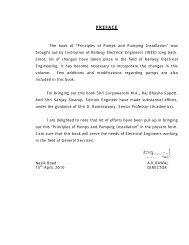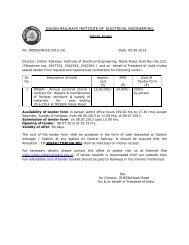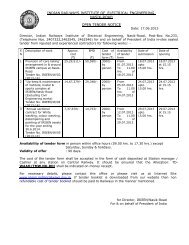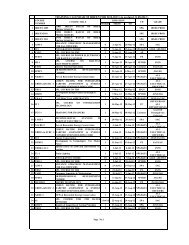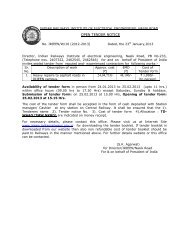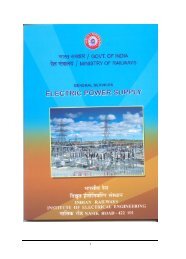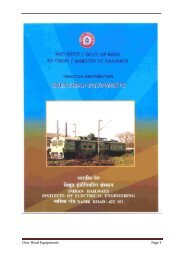remote control equipment - Indian Railways Institute of Electrical ...
remote control equipment - Indian Railways Institute of Electrical ...
remote control equipment - Indian Railways Institute of Electrical ...
Create successful ePaper yourself
Turn your PDF publications into a flip-book with our unique Google optimized e-Paper software.
ii) For cables where the above tests are not made, an rms value equal to 60% <strong>of</strong> the<br />
lowest dc voltage to 85% <strong>of</strong> the lowest ac voltage used in factory tests to ensure the<br />
breakdown strength between conductors and sheath or screen unless there is reason to fear<br />
that the laying and jointing operations have caused any appreciable reduction in the<br />
breakdown point. In such cases, special studies should be made to select the method for<br />
determining the permissible limit.<br />
Where only some <strong>of</strong> the cable pairs are terminated satisfying the above conditions, the<br />
voltage limit indicated in (i) or (ii) is permitted on such cable pairs provided that the dielectric<br />
strength from other parts in the cable is sufficient to avoid breakdown.<br />
The isolating transformers and other line apparatus should have a dielectric strength<br />
equivalent to or greater than available on the cable conductors, unless lightning protectors are<br />
used.<br />
Experience shows that dangerous levels <strong>of</strong> induced voltage are unlikely on cable<br />
conductors where the above conditions are met and where faults on medium voltage inducing<br />
lines are involved and where protective devices are used. Where the permissible induced<br />
voltage on cable conductors is increased above the permissible levels for open wire lines, it is<br />
desirable to consider safety precautions when work is carried out on these cables and to<br />
ensure that <strong>equipment</strong> connected to the line can withstand the resultant common mode<br />
voltages and currents.<br />
Allowance may need to be made when considering permitted induced voltages induced into<br />
Cables carrying significant telecommunications voltages (e.g. power feeding systems).<br />
8.1.3 Permissible capacitively – coupled current :<br />
In cases <strong>of</strong> capacitive coupling, a resulting current through a contact between a<br />
conductor and earth <strong>of</strong> other metallic structure, upto 10 mA is permissible.<br />
8.2 COUPLING BETWEEN CIRCUITS:<br />
The coupling between two circuits may be conductive or alternately due to electric or<br />
the magnetic field. These are distinguished as conduction, electrostatic induction and<br />
electromagnetic induction. Even when all the three kinds <strong>of</strong> couplings occur simultaneously,<br />
usually one <strong>of</strong> them will usually prevail.<br />
8.3 CONDUCTIVE COUPLING:<br />
Conductive coupling is present when two circuits I and II have a common branch (See<br />
Fig.8.1). If the common branch is sufficiently well defined the distribution <strong>of</strong> the current and the<br />
effect produced in II may be calculated. If they are coupled by a common resistance “r”, the<br />
parasitic current I in circuit II is given by<br />
I = Er_____<br />
RW + Rr + Wr<br />
Generally, Wr >> R >> r because I is a power circuit and II a telecommunication circuit.<br />
It is approximately equal to I = Fr/RW. The effect in II is same as if a parasitic voltage<br />
143






